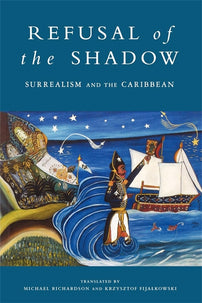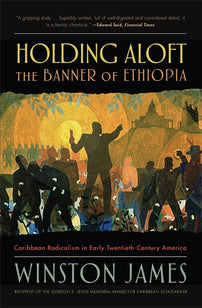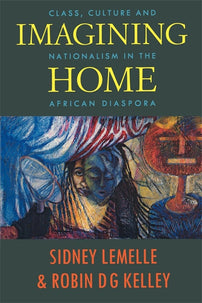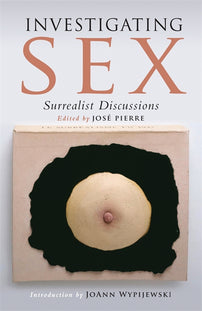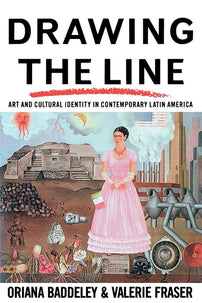The Great Camouflage
"We must dare to point out the Caribbean stain on France's face, since so many of the French seem determined to tolerate no shadow of it."

In the 1930s and 40s, Francophone Caribbean intellectuals critically engaged French surrealists across a series of publications. Refusal of the Shadow: Surrealism and the Caribbean, edited by Michael Richardson and published by Verso in 1996, collects key texts from this exchange, beginning with the first and only issue of Légitime défense, the journal of the Sorbonne-based Caribbean Surrealist Group, published in 1932.
Among the readers of Légitime défense, which was quickly banned by French authorities, were Aimé and Suzanne Césaire and philosopher René Ménil. All three would return to their native Martinique, where in 1941 they established Tropiques, a publication central to the development of the concept of négritude. The journal, Michael Richardson writes, "would function simultaneously on three ideological levels: as a focus for a developing black consciousness in Martinique; as a covert locus for the anti-Vichy struggle (during the war Martinique was ostensibly administered by Vichy); and as a journal of international surrealism."
The editors of Tropiques were drawn to surrealism from different perspectives. For [Aimé] Césaire it was essentially a poetic tool, a means to use language, and a moral sensibility. Surrealism affirmed something he had long felt; it was, he said, "a confirmation of what I had found through my own reflections." For Ménil and for Suzanne Césaire, on the other hand, surrealism was more of a critical tool, a means of reflection that would provide them with a critical foundation from which to explore their own cultural context.
Below we present Suzanne Césaire's "The Great Camouflage," published in Tropiques nos. 13–14 in 1945, a remarkable lyric essay on the history of the Americas and the African diaspora and the social relations of race, color, and class in Martinique.
Crammed against the islands are the beautiful green blades of water and silence. Around the Caribbean Sea is the purity of salt. Down there in front of me is the pretty square of Pétionville, planted with pine and hibiscus. My island, Martinique, is there, with its fresh garland of clouds prompted by Mount Pelée. There are the highest plateaux of Haiti, where a horse is dying, struck by lightning in the ageold murderous storm of Hinche. Nearby, his master contemplates the land he used to believe was solid and generous. He does not yet realize that he is participating in the islands' absence of equilibrium. But this outburst of terrestrial insanity illuminates his heart: he starts thinking about the other Caribbean islands, with their volcanoes, their earthquakes and their hurricanes.
At that moment a powerful cyclone starts to swirl in the open seas off Puerto Rico in the midst of billows of clouds, its beautiful tail sweeping the length of the Caribbean semicircle. The Atlantic flees towards Europe in great ocean waves. Our little tropical observation posts start to crackle out the news. The wireless is going mad. Ships flee — where can they go? The sea swells, this way, that way, with an effort, a luscious leap, the water stretches out its limbs as it gains greater awareness of its watery strength; sailors clench their teeth and their faces are streaming wet, and it is reported that the cyclone is passing over the south-east coast of the Haitian Republic at a speed of thirty-five miles per hour as it heads for Florida. Those objects and beings still just out of reach of the wind are gripped with apprehension. Don't move. Let it pass by...
In the eye of the cyclone everything is snapping, everything is collapsing with the rending sound of tumultuous events. The radios fall silent. The great palm-tree tail of fresh wind is unfolding somewhere in the stratosphere where no one will follow its wild iridescence and waves of purple light.
After the rain, sunshine.
The Haitian cicadas consider chirping out their love. When not a drop of water remains on the scorched grass, they sing furiously about the beauty of life and explode into a cry too vibrant for an insect's body. Their thin shell of dried silk stretched to the limit, they die as they let out the world's least moistened cry of pleasure.
Haiti remains, shrouded in the ashes of a gentle sun with eyes of cicadas, shells of mabouyas, and the metallic face of a sea that is no longer of water but of mercury.
Now is the moment to lean out of the window of the aluminium clipper on its wide curves.
Once again the sea of clouds appears, which is no longer intact since the planes of Pan American Airways pass through. If there is a harvest in process of ripening, now is the time to try to glimpse it, but in forbidden military zones the windows remain closed.
Disinfectant or ozone is brought out, but it hardly matters, you'll see nothing. Nothing but the sea and the confused lay of the land. You can only guess at the uncomplicated loves of the fishes. They stir the waters, which give a friendly wink to the clipper's windows. Seen from high above, our islands assume their true dimensions as seashells. The hummingbird-women, the tropical flower-women, the women of four races and dozens of blood ties, have gone. So too have the canna, the plumiera and the flame tree, the moonlit palm trees, and sunsets seen nowhere else on earth ...
Nevertheless they're there.
Yet it was fifteen years ago that the Caribbean was disclosed to me from the eastern slope of Mount Pelée. From there I realized, as a very young girl, that, as it lay in the Caribbean Sea, Martinique was sensual, coiled, spread out and relaxed, and I thought of the other islands, equally beautiful.
I experienced the presence of the Caribbean once more in Haiti, on summer mornings in 1944, which was so much more perceptible in the places from which, at Kenscoff, the view over the mountains is of an unbearable beauty.
And now complete lucidity. My gaze, going beyond these perfect forms and colours, catches by surprise the torment within the Caribbean's most beautiful face.
Because the thread of unsatisfied desires has caught the Caribbean and America in its trap. Since the Conquistadors arrived and their technology (starting with firearms) developed, not only have the transatlantic lands had their appearance changed, they have learned new fears. Fear of being outdistanced by those who remained in Europe, already armed and equipped; fear of being confused with the coloured peoples who were immediately declared inferior in order to make it easier to bully them. It was necessary initially and at any price — be it the price of the infamy of the slave trade — to create an American society richer, more powerful and better organized than the forsaken but desired European society. It was necessary to take revenge on the nostalgic hell which vomited its adventurous demons, its convicts, its penitents and its utopians over the New World and its isles. The colonial adventure has continued for three centuries — the wars of independence being only one episode — and the American peoples, whose attitude towards Europe often remains childish and romantic, are not yet freed from the old continent's grip. Naturally it is the American blacks who suffer most from the daily humiliations, degeneracies, injustices and shabbiness of colonial society.
If we are proud to proclaim our extraordinary vitality throughout the Americas, if it seems to promise us a definitive salvation, we need the courage to say that subtle forms of slavery remain rampant. Here, in these French islands, it still debases thousands of negroes, for whom a century ago the great Schoelcher demanded, in addition to liberty and dignity, the title of citizens. We must dare to point out, caught by the implacable spotlight of events, the Caribbean stain on France's face, since so many of the French seem determined to tolerate no shadow of it.
The degrading forms of modern wage labour still find a plot of land upon which to flourish unchecked among us.
Who will cast out, along with obsolete factory machinery, the thousands of sub-industrialists and grocers, that caste of false colonists responsible for the human decline of the Caribbean?
As they drift along the streets of the capitals among their European brothers, an unsurmountable timidity fills them with fear. Ashamed of their languid accent and rough French, they sigh for the calm warmth of their Caribbean homes and the patois of the black da of their childhood. 1
Prepared for any form of betrayal in order to defend themselves against the mounting tide of blacks, they would sell themselves to America (if the Americans didn't claim that the purity of their blood is more than suspect) just as, in the forties, they proclaimed allegiance to the Vichy admiral: Pétain being the altar of France for them, Robert had to become the "tabernacle of the Caribbean." 2
Meanwhile, the Caribbean serf lives miserably and abjectly on the "factory" lands, and the mediocrity of our market towns is a sickening sight. Meanwhile, the Caribbean is still a paradise with the gentle sound of palm trees ...
That day the irony was that, a garment gleaming with sparks, each of our muscles expressed in its own way part of the desire scattered over the blossoming mango trees.
I listened very attentively to your voices lost in the Caribbean symphony which launched downpours to assault the isles, but could not hear them. We were like thoroughbreds, held in check but chafing at the bit, on the edges of this salt savanna.
On the beach were several "metropolitan officials." They stood there uneasy, ready to flee at the first signal. Newcomers have difficulty adapting to our "old French lands." When they lean over the baleful mirror of the Caribbean Sea, they see their own delirious image. They don't dare recognize themselves in that ambiguous being, the West Indian. They know the métis has some of their blood; that they both belong to Western civilization. Of course, "metropolitans" are unaware of colour prejudice. But their coloured descent fills them with fear, in spite of the exchange of smiles. They didn't expect this strange burgeoning of their blood. Perhaps they would prefer not to respond to their Caribbean heirs who simultaneously cry out and do not cry out, "Father." Yet they have to reckon with these unexpected sons and charming daughters. They have to govern this turbulent people.
Here's a West Indian, the great-grandson of a colonist and a black slave woman. Here he is in his island, ensuring its "smooth running" by his deployment of all the energies once needed by avaricious colonists for whom the blood of others was the natural price of gold and all that courage needed by African warriors in their perpetual struggle to wrest life from death.
Here he is with his double strength and double ferocity, in a dangerously precarious equilibrium: he cannot accept his negritude, but nor can he make himself white. Listlessness overcomes this divided heart, and with it come habits of trickery, a fondness for "fiddles"; this is how that flower of human servility the coloured bourgeoisie blooms in the Caribbean.
Along roads bordered with glyciridia pretty black children, relishing the cooked roots — salted or unsalted — that they eat, smile at the posh car as it passes. They suddenly feel, in the pits of their stomachs, the need one day to be masters of a beast so supple and shiny and powerful. Years later, stained with the fat of comfort, they can be seen miraculously giving a quivering of life to rejected carcasses, in order to sell them for a song. The hands of thousands of young West Indians have instinctively weighed up the steel, considered the joints and loosened the screws. Thousands of images of gleaming factories, unwrought steel and liberating machines have swelled the hearts of our young workers. In hundreds of sordid sheds where scrap iron rusts, there is an invisible vegetation of desires. The impatient fruits of the Revolution will inevitably gush forth from it.
Here among the mornes smoothed by the wind is the Free-Men's Estate. A peasant, in whom the mechanical adventure still inspires no excitement, leans against a giant mapou which shades the whole side of the morne, feeling a dull thrust of vegetation welling up through him from his bare toes as they sink into the mud. Turning towards the setting sun to see what the weather will be like tomorrow — the orangeish red indicates that planting time is near at hand — and his gaze is not only the gentle reflection of the light, but becomes oppressive with impatience, the very one which stirs the Martiniquan earth — this earth which does not belong to him yet is his earth. He knows that it is in league with them, the workers, and not with the béké or the mulatto. And when suddenly, in the Caribbean night decked out with love and silence, the drum roll explodes, the blacks get ready to respond to the desire of the earth and of dance, but the landowners, immured in their beautiful mansions behind their wire gauze, appear like pale butterflies caught in a trap under the electric light.
All around them the tropical night swells with rhythm, Bergilde's hips have assumed, in the oscillations that surge from the chasms on volcano flanks, their appearance of cataclysm and it is Africa itself which, beyond the Atlantic and the centuries before the slave traders, dedicates the look of solar lust exchanged by the dancers on its West Indian children. Their cries proclaim, in a raucous and generous voice, that Africa is here, present; that it is waiting, immensely chaste despite the stormy, devouring colonization by the whites. And across these faces constantly bathed in the effluvium of the sea around the islands, across these bounded and small lands surrounded with water like huge impassable gulfs, passes the remarkable wind that has come from a continent. The Caribbean-Africa, thanks to the drums and the nostalgia for terrestrial places, lives on in the hearts of these island peoples. Who will satisfy their nostalgia?
Yet Absalom's canna bleeds on the chasms and the beauty of the tropical landscape goes to the heads of passing poets. Through the shifting tracery of the palms, they see the West Indian blaze swirling over the Caribbean Sea which is a calm sea of lava. Here life is kindled by a vegetal fire. Here, on the warm earth that keeps alive geological species, the plant, through passion and blood, through its primitive architecture, establishes disquieting chimes surging from the dancers' chaotic loins. Here the liana, vertiginously balanced, assumes aerial poses to charm the precipices, hooking trembling hands to the ungraspable cosmic trepidation that mounts right through nights inhabited with drums. Here poets feel their heads reeling and, imbibing the fresh odours of the ravines, they seize the spray of the islands, listen to the sound the water makes around them, and see the tropical flames no longer revive the canna, the gerbera, the hibiscus, the bougainvillaea and the flame trees, but instead the hungers, the fears, the hatreds and the ferocity that burns in the hollows of the mornes.
And so the conflagration of the Caribbean Sea heaves its silent vapours, blinding for the only eyes able to see and suddenly the blues of the Haitian mornes and the Martiniquan bays fade, the most dazzling reds pale, and the sun is no longer a crystal that plays, and if the market squares have chosen the tracery of Jerusalem thorns as luxury fans to ward off the sky's ardour, if the flowers have known how to find just the right colours to make you fall in love, if the arborescent ferns have secreted golden essences for their croziers, coiled up like a sex, if my West Indies are so beautiful, it shows that the great game of hide and seek has succeeded and certainly that day would be too lovely for us to see it.
Notes
1. Da: nurse.
2. Robert: Admiral Robert, who effectively governed Martinique on behalf of Vichy from 1941 to 1943.

